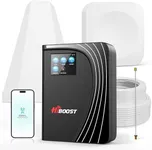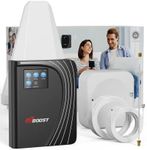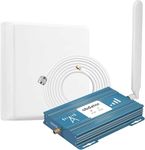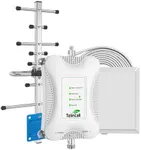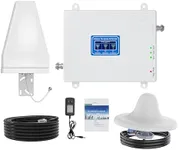Buying Guide for the Best Verizon Home Cell Signal Boosters
Choosing the right Verizon home cell signal booster can significantly improve your mobile phone reception, ensuring you have strong and reliable connectivity throughout your home. When selecting a signal booster, it's important to consider several key specifications to ensure it meets your needs. Understanding these specifications will help you make an informed decision and choose the best product for your situation.Coverage AreaCoverage area refers to the size of the space that the signal booster can effectively cover. This is important because it determines how much of your home will benefit from improved signal strength. Coverage areas are typically measured in square feet. Small boosters may cover areas up to 1,500 square feet, suitable for apartments or small homes. Medium boosters can cover areas between 1,500 to 3,000 square feet, ideal for medium-sized homes. Large boosters can cover areas over 3,000 square feet, perfect for large homes or multi-story buildings. To pick the right one, consider the size of your home and the areas where you need better signal.
Frequency BandsFrequency bands refer to the specific radio frequencies that the signal booster can amplify. Verizon uses several frequency bands for its network, including 700 MHz, 1700/2100 MHz, and 1900 MHz. It's important to choose a booster that supports the frequency bands used by Verizon in your area to ensure compatibility and optimal performance. Check with Verizon or use online tools to determine the frequency bands used in your location. If you are unsure, opt for a booster that supports multiple bands to cover all possibilities.
GainGain is a measure of how much the signal booster can amplify the incoming signal. It is measured in decibels (dB). Higher gain means stronger amplification, which can be crucial in areas with very weak signals. Boosters typically offer gain levels ranging from 50 dB to 70 dB. For urban areas with moderate signal strength, a lower gain booster may suffice. In rural or remote areas with very weak signals, a higher gain booster is recommended. Assess the current signal strength in your home to determine the appropriate gain level.
Number of UsersThe number of users refers to how many devices can simultaneously benefit from the boosted signal. Some boosters are designed to support multiple users, while others may be limited to fewer devices. If you have a large family or multiple devices that need improved signal, choose a booster that can handle multiple users without compromising performance. Typically, boosters can support anywhere from a few devices to dozens of devices. Consider the number of people and devices in your household when making your choice.
Installation TypeInstallation type refers to how the signal booster is set up in your home. Some boosters are plug-and-play, requiring minimal setup and technical knowledge, while others may require more complex installation involving external antennas and cabling. If you prefer a simple setup, look for boosters with easy installation processes. For those comfortable with more technical installations, a booster with external antennas may offer better performance. Consider your comfort level with installation and whether you might need professional help.
